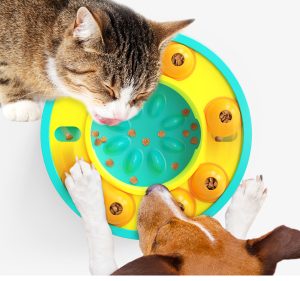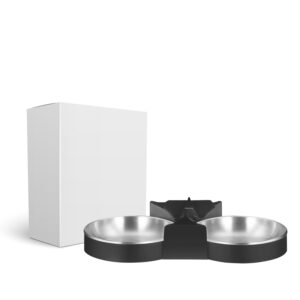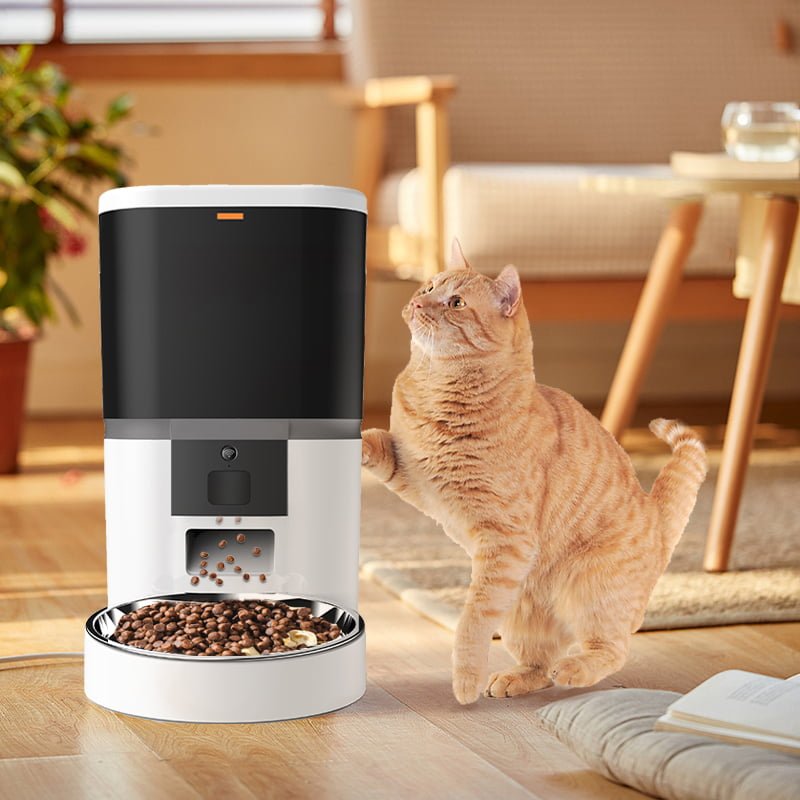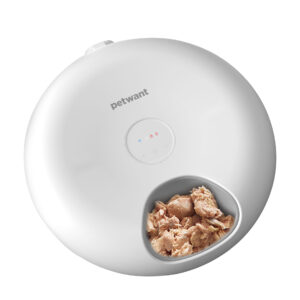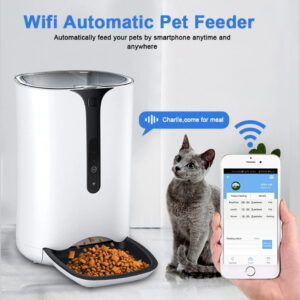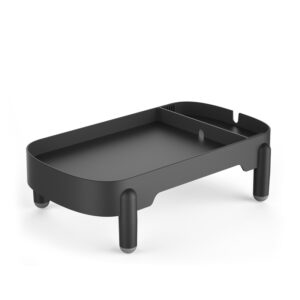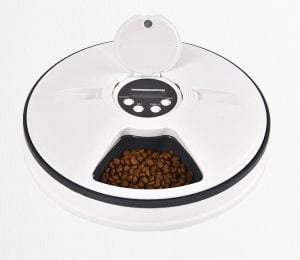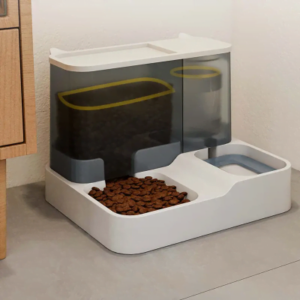0
Feeding Puppies and Kittens: Early Nutrition 101
Feeding your puppy or kitten well in their first year sets the stage for a healthy, happy life. Growth is fast, needs change quickly, and small adjustments can make a big difference. This guide gives you clear schedules, weaning steps, portion and calorie tips, and practical tools to help you stick to the plan.
Friendly note from TailMe: Throughout this guide, you’ll see simple, age-by-age steps and solutions you can put to work today. Where tools help you keep a schedule or slow down fast eaters, we’ll point you to useful options.
—
Table of contents
- Puppy and Kitten Feeding Schedules by Age (0–12 months)
- Weaning (4–8 weeks): step-by-step
- How much to feed: portions and calories
- Large vs small breed puppy nutrition
- Kitten-specific needs
- When to switch to adult food
- Hydration: wet vs dry
- Free feeding vs scheduled meals
- Orphaned newborn care (bottle-feeding)
- Red flags and when to call the vet
- Tools to stay on schedule (smart/auto feeders)
- FAQs
- Sources
—
Puppy and Kitten Feeding Schedules by Age (0–12 months) {#schedules}
Quick answers for common searches:
- 8 week old puppy feeding schedule: 3–4 small meals per day, evenly spaced.
- 12 week puppy — how many meals a day? Typically 3 meals.
- Kitten feeding schedule at 4/6/8/12 weeks: see below.
Puppies
- 0–4 weeks (neonatal): Mother’s milk or species-appropriate milk replacer only. Feed every 2–3 hours in week 1; every 3–4 hours by weeks 3–4.
- 4–8 weeks (weaning): Transition from milk to gruel, then to solid growth food. Offer 4 meals/day.
- 2–3 months: 4 meals/day.
- 3–6 months: 3 meals/day.
- 6–12 months: 2 meals/day (giant breeds may need 3 smaller meals to reduce gulping).
Kittens
- 0–4 weeks (neonatal): Queen’s milk or kitten milk replacer. Every 2–3 hours in week 1; stretch to every 4 hours by weeks 3–4.
- 4 weeks: Start weaning with warm gruel; 4–6 small meals/day.
- 6–8 weeks: 4–6 meals/day (tiny stomachs, high needs).
- 2–6 months: 4 meals/day.
- 6–12 months: 3–4 meals/day.
Helpful tool: Need reliable timing for 4+ meals? A smart feeder keeps the routine when life gets busy. TailMe picks to explore after this section.
—
Weaning (4–8 weeks): step-by-step {#weaning}
Puppies (weaning puppies at 4 weeks: easy gruel recipe) 1) Warm water or puppy formula + growth puppy food. 2) Start 3 parts warm liquid to 1 part dry (or 2 parts to 1 part wet food). Aim for a soupy, easily lappable consistency. 3) Offer 3–4 times/day; let pups explore and lick. 4) Over 2–3 weeks, thicken to 1:1, then gradually reduce added liquid until eating solid food comfortably by 7–8 weeks. 5) Always provide fresh water.
Kittens (weaning kittens at 4 weeks: step-by-step) 1) Mix kitten wet food with warm water or kitten formula (about 3:1 liquid-to-food to start). 2) Offer 4–6 small “taste sessions” daily. 3) Thicken every few days as they lap more confidently. 4) Keep litter boxes nearby and clean; kittens often eat, then eliminate. 5) Transition fully to a complete and balanced kitten diet by 7–8 weeks.
Food safety
- Warm gruel to body temperature (about 37–38°C / 99–100°F).
- Discard leftovers after 20–30 minutes.
- Wash bowls after each meal.
—
How much to feed: portions and calories {#portions}
Start here, then fine-tune based on your pet’s body condition and energy.
Calorie basics
- Resting Energy Requirement (RER) = 70 × (body weight in kg)^0.75.
- Growth factors (typical ranges):
– Puppies: 0–4 months ˜ 2.5–3.0 × RER; 4–12 months ˜ 1.6–2.0 × RER. – Kittens: weaning–4 months ˜ 2.5–3.0 × RER; 4–12 months ˜ 1.6–2.5 × RER.
- Convert calories to food: Daily cups/grams = Daily kcal needed ÷ kcal per cup/100 g (check the bag/tin).
Example
- 8 kg puppy, 3 months old:
– RER ˜ 70 × 8^0.75 ˜ 70 × 4.76 ˜ 333 kcal. – Daily target ˜ 2.5 × 333 ˜ 830 kcal/day. – If food is 380 kcal/cup, feed ˜ 2.2 cups/day, split into 3–4 meals.
- 1.2 kg kitten, 10 weeks:
– RER ˜ 70 × 1.2^0.75 ˜ 70 × 1.15 ˜ 81 kcal. – Daily target ˜ 2.8 × 81 ˜ 225 kcal/day. – Split into 4–6 small meals, ideally with a wet + dry mix for hydration and variety.
Fine-tune with a quick body check (BCS)
- Ribs: Easy to feel with a light fat cover (not sharp, not buried).
- Waist: Visible from above; tummy tucks up from the side.
- If ribs are sharp/hips visible ? increase food 5–10%.
- If no waist / belly rounded ? decrease food 5–10%.
Reassess weekly during growth.
Portion pro tip
- Sudden growth spurts happen. Recalculate every 2–4 weeks and after big weight changes.
- A slow or smart feeder can pace fast eaters and help prevent gulping.
—
Large vs small breed puppy nutrition {#large-breed}
Large and giant breeds (adult weight =30 kg) need controlled growth to protect joints.
- Choose diets that meet AAFCO “Growth including growth of large-size dogs.”
- Calcium–phosphorus guidance (typical safe ranges on a dry matter basis):
– Calcium ˜ 1.2–1.8% – Phosphorus ˜ 1.0–1.6% – Ca:P ratio ˜ 1:1 to 1.8:1 (many vets aim ~1.2–1.4:1)
- Avoid adding calcium or high-calorie toppers that accelerate growth.
- Look for added DHA and appropriate energy density for steady—not rapid—growth.
Small breeds grow faster to adulthood but have tiny stomachs.
- Use energy-dense small-bite puppy foods.
- Keep meals small and frequent in early months.
—
Kitten-specific needs {#kittens}
- Frequency: 4–6 meals/day early on; 3–4 meals/day from 6 months.
- Calories: Kittens need more kcal per kg than puppies; use the RER × growth factors above.
- Wet vs dry for growth:
– Wet food boosts hydration, aroma, and palatability. – Dry food adds crunch and convenience. A mixed plan often works best.
- Multiple small meals suit their metabolism. An automatic feeder that handles small portions (and a wet food dispenser with an ice pack) makes consistency easy.
—
When to switch to adult food {#switch}
- Small-breed dogs: 9–12 months.
- Large/giant-breed dogs: 12–18 months (some giants up to 24 months—ask your vet).
- Kittens: Around 12 months.
Make the change slowly over 7–10 days: increase the new food a little more each day to avoid tummy upsets.
—
Hydration: wet vs dry {#hydration}
- Always offer fresh, clean water.
- Wet food helps cats (and some pups) meet fluid goals and can be scheduled safely with a wet-food automatic feeder with an ice pack.
- Dry food works well with smart feeders for precise portions and timing.
- Avoid milk; most pets become lactose intolerant and may get diarrhea.
—
Free feeding vs scheduled meals {#free-vs-scheduled}
Puppy free feeding vs scheduled feeding—pros and cons
- Free feeding (food always available)
– Pros: convenient for grazers. – Cons: easy to overeat; tougher to housetrain; risky for fast eaters/bloat-prone breeds.
- Scheduled feeding
– Pros: portion control, predictable potty times, easier weight management. – Cons: needs routine (a smart or gravity feeder can help when you’re out).
For multi-pet homes, consider a microchip feeder to stop food stealing and reduce guarding.
—
Orphaned newborn care (bottle-feeding) {#newborns}
Never use cow’s milk. Use puppy- or kitten-specific milk replacer and follow label directions.
How much and how often (general daily totals)
- Newborn kitten milk replacer—how much and how often:
– Rough guide: 20–30 mL per 100 g body weight per day, split into feeds every 2–3 hours (week 1), then every 3–4 hours by weeks 3–4.
- Newborn puppy milk replacer feeding (daily ballpark):
– Rough guide: 13–20 mL per 100 g body weight per day, split into feeds every 2–3 hours (week 1), then every 3–4 hours by weeks 3–4.
How to bottle feed a kitten/puppy (step by step) 1) Warm formula to 37–38°C (99–100°F). Test on your wrist. 2) Hold the baby belly-down (“sphinx” position), never on the back. 3) Use a small nursing bottle; let them suckle—do not squeeze hard. 4) Burp gently after feeding. 5) Stimulate to urinate/defecate with a warm, damp cotton pad until ~3–4 weeks. 6) Weigh daily; healthy gain is roughly 5–10% body weight per day.
Call the vet urgently for weak suckling, bloating, vomiting, diarrhea, or failure to gain weight for 24 hours.
—
Red flags and when to call the vet {#red-flags}
- Stunted growth or excessive weight gain
- Dull coat, flaky skin, or itching
- Abnormal posture or limping
- Persistent diarrhea, vomiting, or bloating
- Lethargy, poor appetite, or sudden behavior change
Regular vet check-ins during the first year help catch issues early and tailor portions accurately.
—
Tools to stay on schedule (smart/auto feeders) {#tools}
Plan the routine, then let tools help you execute it.
- Set 4-meal puppy/kitten schedules:
– Classic Connected AutoFeeder or Elegant Connected Auto Feeder: program exact times and portions so you never miss a feed. – Classic Connected Feeder Dual Bowls: ideal for multi-pet homes on one schedule.
- For wet food and kittens:
– Wet Pet Food Dispenser with an ice pack keeps wet meals safe and fresh.
- For fast-eating dogs:
– Doggy Slow Puzzle Feeder: slows gulping to reduce vomiting or gas and promotes calm mealtimes.
- Simple and hands-off:
– AquaMunch Gravity Feeder: helpful for steady nibblers (avoid for pets that overeat).
- Keep bowls at the right height:
– Auto Feeder Stands: better posture and cleaner feeding area.
Gravity vs smart vs wet dispenser—what’s better?
- Gravity feeder: simplest, no power, but no portion control.
- Smart feeder: precise portions and timing; great for weight management and routine.
- Wet-food dispenser: best for cats and kittens needing frequent wet meals; use with ice pack for food safety.
—
FAQs {#faqs}
Q: Can I free feed my puppy or kitten? A: Kittens may do well with frequent access to food, but scheduled meals are safer for puppies and any pet that tends to overeat. In multi-pet homes, microchip feeders help prevent food stealing.
Q: How many meals for a 3/6/9/12-month puppy? A: 3 months: 3–4 meals; 6 months: 2–3 meals; 9–12 months: 2 meals (giants may benefit from 3 smaller meals).
Q: Is cow’s milk safe? A: No. Use species-appropriate milk replacer only.
Q: Signs you’re overfeeding? A: Rapid weight gain, no visible waist, soft stools, flatulence, low energy after meals. Reduce portions by 5–10% and reassess in 1–2 weeks.
Q: Do puppies/kittens need supplements like DHA? A: If you feed a complete and balanced growth diet, extra supplements are usually unnecessary. DHA is helpful, but it should already be included in quality growth formulas. Ask your vet before adding anything.
Q: When to switch puppy to adult food (small vs large breed)? And when to switch kittens? A: Small dogs: 9–12 months. Large/giant: 12–18+ months (up to 24 months for some). Kittens: ~12 months.
Q: Kitten wet vs dry food for growth? A: A mixed plan often works best: wet for hydration and palatability, dry for convenience and dental texture, split into multiple small meals.
—
Sources {#sources}
- AAFCO Dog and Cat Food Nutrient Profiles (growth, including growth of large-size dogs)
- FEDIAF Nutritional Guidelines for Complete and Complementary Pet Food
- WSAVA Global Nutrition Toolkit (calorie calculations and growth advice)
- VCA and other veterinary hospital resources on neonatal care and weaning
—
Caring, expert tip from TailMe
- Start with the schedule above, then adjust slowly using body condition and energy as your compass.
- Use tools that reduce friction (smart feeders, slow bowls, wet dispensers) so real life doesn’t derail a good plan.
- When in doubt, your veterinarian’s guidance—plus steady tracking of weight and body condition—will keep your youngster on the healthiest path.

